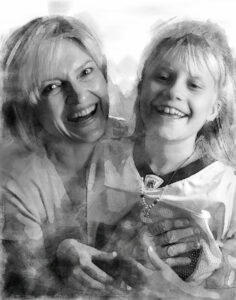By Larissa Warneck-Silvestrin
July 24th of 2006. It’s a date that you never forget.”
On that fateful Monday, Sharon King and her husband were told by a geneticist that their seven-year-old daughter, Taylor, had a rare genetic disease. They asked the geneticist what they could do and where to seek help.

“He shook his head and said, ‘This is such a rare disease, there is not much you’re going to be able to do in her lifetime and very likely your own’,” Sharon King, manager of advocacy and community engagement at Aldevron and co-founder and president of Taylor’s Tale, told Inside Precision Medicine.
The Kings were advised to take Taylor home and make as many happy memories as possible. But hearing the doctor’s response lit a fire in Sharon King’s heart: “To me, his words sounded like ‘too rare to care.’”
Rare diseases: not so rare after all?
The Kings decided not to sit back and accept Taylor’s fate. They founded the charity Taylor’s Tale and soon realized that their story wasn’t unique. “We were one family in a huge group of families,” King explained. “In the rare disease space, we didn’t share the same condition, but we shared the same outcomes and the same need for hope.”
In the United States, the Food and Drug Administration (FDA) defines a rare disease as a disease or condition that affects fewer than 200,000 people. But while individual rare diseases can impact only a small number of people, taken together, approximately 25 to 30 million Americans are affected. Worldwide, there are an estimated 260 to 450 million rare disease patients.

Despite these large patient numbers, only 500 of the 7,000 identified rare genetic diseases have approved treatments. Like Taylor, many rare disease patients are children. Patients and their caregivers are often forced to travel long distances to receive treatments that need to be given repeatedly and will only address their symptoms.
“Knowledge and funding for rare diseases lag behind more common diseases,” said Julie Gerberding, MD, president and CEO of the Foundation for the National Institutes of Health (FNIH). “There is typically little to no commercial interest for a disorder that may only affect a dozen or so patients, so too many patients are left to deal with these devastating genetic diseases with little or no hope for beneficial treatments.”
Gene therapies for monogenic rare diseases
At least 80% of rare diseases are monogenic. This means that they are caused by single gene mutations. A potential treatment—and even cure—would have to replace that gene with a functional copy.
“Gene therapies can be tailor-made to address the specific faulty gene in the patient,” explained Gerberding. “Rather than utilizing a symptomatic treatment, gene therapy seeks to deliver precision treatment directly to the affected gene, replacing defective genes with functional ones.”
Taylor King, for example, was diagnosed with a form of Batten disease called CLN1, a rare disease that primarily affects the nervous system. In CLN1, mutations in the PPT1 gene decrease the production or function of the enzyme palmitoyl-protein thioesterase 1.
As a result, fatty acids cannot be removed from certain proteins, so they collect in cells’ lysosomes. Nerve cells are particularly affected by this accumulation of partially broken-down fats and proteins, causing widespread nerve cell death.
People diagnosed with CLN1 suffer from vision loss, a progressive decline in motor and cognitive functions, seizures, and ultimately, early death. A gene therapy for CLN1 disease would have to deliver a functional copy of the PPT1 gene to the central nervous system and peripheral organs.
The story of ABO-202
One day, in her fight for Taylor’s life, Sharon King met Steven Gray, PhD, an assistant professor at the University of North Carolina (UNC) at Chapel Hill, who was working on a novel gene therapy approach. They saw a possibility to adapt the approach for CLN1 disease. “It was a mother’s intuition,” said King.
The Kings began fundraising and on Rare Disease Day 2013, secured the necessary funding to start a CLN1 gene therapy program at UNC. Three years later, the project, called ABO-202, was licensed to Abeona Therapeutics to be developed further.
In May 2019, the FDA accepted the Investigational New Drug (IND) application for ABO-202. “The company is cleared to begin a Phase I/II clinical trial evaluating its novel one-time gene therapy ABO-202 for the treatment of CLN1 disease,” the company wrote in a press release.
“We felt like that was the ticket,” King recalled. “By that point, we knew it wasn’t for Taylor, but it was for somebody’s child and we couldn’t give up on this program.”
However, the euphoria didn’t last long: “The minute the IND was allowed, everything stopped. There was radio silence.”
“I think what happened was there were so many challenges to face and regulatory hurdles to jump, it just didn’t seem to make sense for a very small patient population,” explained King. “That’s when I knew we needed changes to our system to bring forward gene therapies for rare diseases.”
Tackling rare disease gene therapy development challenges
The story of ABO-202 is not unique. Many gene therapy programs for rare diseases fail due to a lack of funding, difficulties in trial design, manufacturing complexities, or regulatory hurdles.

“In gene therapy, you have to get the drug development absolutely right and you have to do this in a timely manner because patients do not have the luxury of time,” Kinnari Patel, president and COO of Rocket Pharma told Inside Precision Medicine. “On top of that, the current regulatory framework is designed for small molecules and biologics, with room for growth to foster gene therapy success.”
This lack of structure within the gene therapy development and regulatory landscape was something King was forced to realize as well. “We were watching our child with an aggressive, progressive disease, the clock was ticking loudly, and while the science was blossoming, everything else around it was not. We were having to follow these procedures and processes, and creating the wheel over and over and over again.”
Something had to change and in 2021, it did. The Accelerating Medicines Partnership, which is a partnership program between the National Institutes of Health (NIH), the FDA, life science companies, and patient organizations, launched the Bespoke Gene Therapy Consortium (BGTC) to establish platforms and standardized processes that speed up gene therapy development for rare diseases.
The BGTC’s work
Managed through the FNIH, the BGTC aims to address current challenges in gene therapy development with a budget of $80.5 million over five years. The BGTC’s key focus areas are basic research, clinical research, manufacturing and production, and regulatory requirements.
Within these, the BGTC focuses exclusively on one of the most common delivery vehicles for gene therapies, namely, adeno-associated virus (AAV) vectors. AAVs can deliver healthy copies of genes into human cells.

“When the BGTC was first designed, it was at a time when AAVs had the most robust safety profiles and offered the most freedom to operate in terms of existing intellectual property,” said Courtney Silverthorn, PhD, associate vice president of translational sciences at the FNIH.
“We didn’t want to be on the cutting edge of new technologies, we wanted to use a delivery model that others would also be able to use as freely as possible for other indications, following the same BGTC processes.”
Scientists funded by the BGTC are working on improving the efficiency of AAVs by investigating their fundamental biology, their delivery mechanisms, and the activation of the therapeutic genes in target cells.
Moreover, the BGTC is running eight clinical trials for eight rare ocular, neurological, and systemic diseases with the hope of successfully treating 60 to 70 patients.
“The main goal of the BGTC is to make it easier to bring any AAV gene therapy for a rare monogenetic disease forward to the clinic,” explained Silverthorn.
“We want to use those eight clinical trials to validate a process that anyone can use going forward, and make it easier to safely bring new therapies to the clinic for thousands of rare diseases, and potentially benefit millions of patients.”
The first BGTC Regulatory Playbook
For this purpose, the FNIH and the BGTC have come together to create the first Regulatory Playbook that will help biotech companies navigate the regulatory processes needed to advance AAV gene therapies through IND and first-in-human trials.
“This first version is a consolidation of publicly available information, such as FDA guidance, academic research, and patient resources, supplemented with the subject matter expertise of the extensive consortium membership—many of whom have had experience with the regulatory process for rare disease gene therapies,” explained Silverthorn.
In future versions of the Regulatory Playbook, the BGTC is planning to include key learnings from their clinical trials. The idea is to use standardized critical quality attributes, a standard set of pre-clinical testing protocols, and standard templates for regulatory submissions. This way, biotech and biopharma companies can follow a step-by-step guide to rare disease gene therapy development.

“The new playbook represents a first step toward standardizing procedures and processes established by industry and regulatory agency leaders over the years while understanding the specific risk/benefit profile for each disease treatment,” said Dennis Huang, chief technical operations officer and executive vice president, gene therapy research and development at Ultragenyx.
“Leveraging standard approaches will help patients, sponsors, and regulatory reviewers understand the most important risk areas to focus on and reduce the time and effort needed for low-risk areas. Gene therapy development will be smarter, regulatory review processes will be efficient, and patients will receive safe and effective gene therapy treatments faster.”
However, some companies may see the exclusive focus on AAVs as restrictive. “There have been enormous advancements in gene therapy delivery technologies, including viral vectors and non-viral methods, like nanoparticles,” explained Silverthorn. “While this BGTC will run through 2027 and will focus exclusively on AAVs, we would certainly be open to other delivery technologies if we’re able to develop a second, follow-on effort in the future.”
Patel added: “The BGTC aims to develop platforms and standards that will speed up development, and this playbook is a good starting point. Given it’s for AAV platforms, it will be good to broaden and see what kind of information becomes available from this work to inform advancing regulatory framework and platform approaches. As the pilot’s promise is realized, current later-stage products are being developed which are moving forward through collaboration with health authorities, patients, and treating physicians.”
Collaboration is key
In the end, the FNIH and all the BGTC’s stakeholders show that collaboration is essential to bring rare disease treatments to patients faster. Although drug development is competitive by nature, important breakthroughs can only be achieved and patients can only be helped if partnerships are formed and all the stakeholders— the NIH, FDA, life science companies, academia, nonprofits, and patient organizations—come together to smoothen the path of rare disease gene therapy development.
“I like to describe the stakeholders that have to work together collectively as ‘rare disease brick masons.’ We’re all working together to build the same thing and we’re laying the foundation, brick by brick by brick.” said King. “We need a plan—like the Playbook—that we can use as a guide to build this structure effectively and efficiently.”
“There needs to be more knowledge-sharing,” Patel agreed. “Gene therapy is more about collaboration than competition. Instead of feeling like we need to compete, what if we share a lot of the basic information, from raw materials to plasmids to analytics platforms? Then each company doesn’t have to create its own pathway forward. If we can collaborate more as an industry and share knowledge that can help save patient lives, that to me is the call for future advancement.”
A ray of hope
In August 2020, Abeona Therapeutics and Taysha Gene Therapies entered into a licensing and inventory purchase agreement for ABO-202. Renamed TSHA-118, the gene therapy for CLN1 disease was soon deprioritized.
Nevertheless, in February 2024, the first CLN1 patient was treated with TSHA-118 under an individual-patient investigator-initiated IND request from RUSH University Medical College.
“It’s hard to describe the joy in that day, particularly knowing that we helped bring this therapy forward and how long we have fought to hear this announcement,” said King. “We are thrilled for the patient and their family.”
However, for Sharon King, this is not the end: “In some ways, I’m only just getting started. Taylor taught me a lot about courage but she also taught me that treating one child is not good enough. We need therapies for all of these children and we can’t just sit back and say ‘too rare to care.’”
Read more:
- Rare Diseases, NIH, November 2023
- Rare disease emerging as a global public health priority, October 2022
- Abeona Therapeutics Announces Licensing of the AIM™ Next Generation AAV Gene Therapy Vector Platform From The University of North Carolina at Chapel Hill, September 2016
- Bespoke Gene Therapy Consortium, June 2023
- Abeona Therapeutics and Taysha Gene Therapies Enter into Licensing and Inventory Purchase Agreements for ABO-202, a Clinical Stage, Novel, One-time Gene Therapy for CLN1 Disease, August 2020
- Joint Statement to the Global Batten Disease Community, February 2024
Larissa Warneck-Silvestrin is a freelance science journalist based in Berlin, Germany. She has a BSc in biology from Friedrich-Schiller University in Jena, Germany, and an MSc in science communication from the University of Kent in Canterbury, U.K. Larissa has written in English and German for several media outlets, including Labiotech, Deutsche Welle, and Inside Precision Medicine. She specializes in biotechnology, health, medicine, innovation, and biology.













